
This chapter describes the health of Nova Scotians relative to standards and norms for good health and includes both physiological measures such as cholesterol and blood pressure, behaviours such as smoking and alcohol consumption, and the prevalence of chronic conditions. In addition, current CVD risk factor prevalence is compared to 1986 data. Finally, participation rates are reviewed for current prevention strategies such as flu immunization and breast exams.
Excess body weight has been linked to several health risks and diseases, including high blood pressure, diabetes, high blood lipids (e.g., cholesterol), certain cancers (e.g., uterus and breast), gall bladder disease, and complications during pregnancy (Nova Scotia Heart Health Program, 1992). Certain diseases such as osteoarthritis may become worse when a person is overweight. The link between overweight and heart disease (through high blood pressure, high blood lipids, and diabetes) is especially important considering that heart disease is the most common cause of death for Canadian and Nova Scotian adults (Heart and Stroke Foundation of Canada, 1995; Nair, Colburn, MacLean&Petrasovits, 1989; Nova Scotia - Saskatchewan Cardiovascular Disease Epidemiology Group, 1989; Statistics Canada, 1993).
To assess the weight status of Nova Scotian adults, Body Mass Index (BMI) [9] was calculated from weights and heights measured during the clinic visit. Figure 2 presents standard BMI values associated with certain levels of health risk.
[1] Health and Welfare Canada, 1991; Health
Education Authority, 1991.

It is disturbing that only 35% of Nova Scotian adults had a BMI in the healthy range of 20-25 [10] (40% of women and 29% of men). Two-thirds of the population had a BMI over 25, indicating an increased health risk (51% of women and 68% of men). Within this group, 44% of adults had a BMI in the unhealthy range of 27 or more, which is consistent with the Nova Scotia Nutrition Survey where 42% had a BMI in this range (Nova Scotia Heart Health Program, Nova Scotia Department of Health,&Health and Welfare Canada, 1993). One-quarter of adult Nova Scotians in the NSHS95 had a BMI over 30, indicating obesity. Overall, women were more likely to have a healthy weight than men. (Table 9).
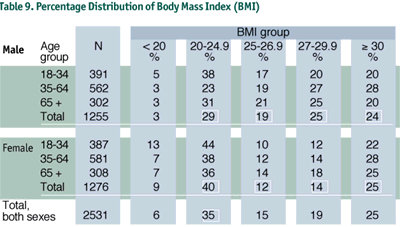
When asked whether they saw themselves as overweight most respondents with a BMI over 25 believed that they were overweight (Table 10). However, only 39% of this group were trying to lose weight, with more women (48%) than men (31%) attempting weight change. Men and women over age 65 who were overweight were less likely to be attempting weight loss than their younger counterparts. Finally, a percentage of men and women with BMI values less than 25 (indicating a weight that is healthy or low) believed that they were overweight (14% of men and 30% of women). Of concern are the 24% of women 18- 34 years old and 18% of women 35-64 years old with a BMI <25 who reported trying to lose weight.
The most common strategies used by Nova Scotians to lose weight included: exercising (71%), eating lower fat foods (66%), and eating less food (61%). More women (72%) than men (57%) were attempting to lose weight by eating lower fat foods (Table 11).
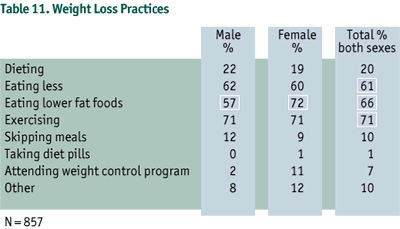
There is scientific consensus that high blood cholesterol is a major risk factor for heart disease and that lowering blood cholesterol levels in individuals with elevated blood cholesterol reduces the risk of heart attack (Jousilahti, Vartiainen and Tuomilehto, Pekannen,&Puska, 1995; Keys, 1980; Pearson&Marx, 1993; The Prevasatin Multinational Study Group for Cardiac Risk Patients, 1993; Rose, 1989; Sytkowski, Kannel&D'Agostino, 1990). Blood cholesterol components contribute to CVD risk in specific ways. Elevated levels of total blood cholesterol, low density lipoprotein (LDL) cholesterol, and triglycerides (TRIG) seem to increase CVD risk, while higher levels of high density lipoprotein (HDL) cholesterol exert a protective, risk lowering effect. (Fortmann, Taylor, Flora,&Winkleby, 1993; NIH Consensus Development Panel on Triglyceride, High-Density Lipoprotein, and Coronary Heart Disease, 1993). It is thus desirable to have low total blood cholesterol, TRIG and LDL cholesterol levels, and high values for HDL cholesterol.
Elevated blood cholesterol levels, commonly found in developed countries, constitute a major public health problem in the western world. The main contributing factor appears to be the western diet high in calories, rich in fat (especially saturated fat) and cholesterol, and low in fibre (NIH Consensus Development Panel on Triglyceride, High-Density Lipoprotein, and Coronary Heart Disease, 1993). In countries where this type of diet is uncommon, population blood cholesterol levels are healthier (Keys, 1980; Rose, 1989).
CVD risk levels associated with the various lipid components are given in Figure 3. These values, taken from international consensus conferences and epidemiological and clinical studies, are accepted measures of population risk for development of CVD.
[1] Expert Panel on Detection, Evaluation
and Treatment of High Blood Cholesterol in Adults, 1993; National
Cholesterol Education Program, 1993; Canadian Consensus Conference on
Cholesterol, 1988.

Blood cholesterol in the NSHS95 was analysed using blood samples collected for all clinic subjects after a minimum eight hour fast. Table 12 presents mean total blood cholesterol levels for all age and sex groups, as well as the percentage of these groups whose cholesterol levels fell in the various risk categories outlined in Figure 3. In a similar fashion, LDL cholesterol, TRIG, and HDL cholesterol values are presented in Tables 13, 14, and 15, respectively.
One-half of adult Nova Scotians had healthy total blood cholesterol levels ( <5.2 mmol/L) and the majority of these were in the 18-34 age group. In general, total blood cholesterol, as well as the percentage of people at risk from high total cholesterol levels, increased with age. These values levelled off in men age 65+ years, yet continued to rise for women in this age group. Men had higher mean total cholesterol levels in the younger age groups (18-64 years) than women, but this situation was reversed after age 65 when women had a higher value (p < 0.05). In fact, older women (65+ years) had the highest mean total blood cholesterol levels of any age and sex group (5.9 mmol/L). Forty-nine percent of adults had some risk due to high blood cholesterol (> 5.2 mmol/L) with 18% at high risk (> 6.2 mmol/L), and it was older women (65+ years) who contributed most to these risk groups (Table 12).
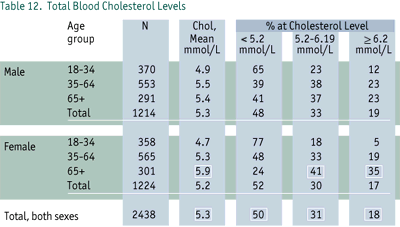
LDL cholesterol and TRIG levels (Tables 13 and 14) showed a similar pattern to total blood cholesterol. Mean values tended to rise with age for both sexes, levelling off for men age 65 and older and continuing to rise for older women. Thirty-eight percent of adults were at risk from elevated levels of LDL cholesterol (> 3.4 mmol/L) and 16% were at high risk (> 4.1 mmol/L), with older women (65+ years) making up the largest percent of both groups. Twenty-two percent of the population was at risk from high blood TRIG levels (> 2.3 mmol/L).
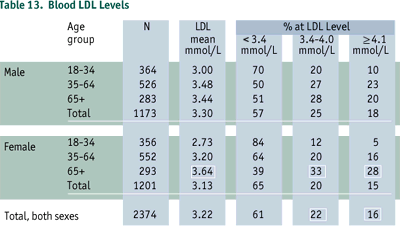
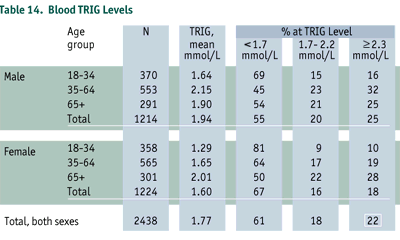
HDL cholesterol levels did not appear to change with age (Table 15). Under age 65, a greater percentage of women had HDL levels > 0.9 mmol/L, indicating a healthier value compared to men, yet over age 65, there was no statistical difference between men and women on this measure. Eleven percent of the population was at risk from low HDL cholesterol (< 0.9 mmol/L), with men of all ages showing greater risk than women.
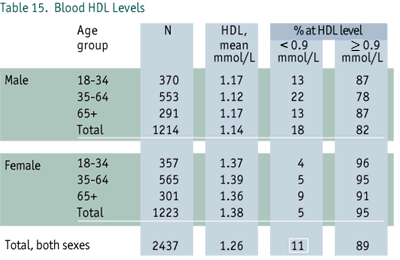
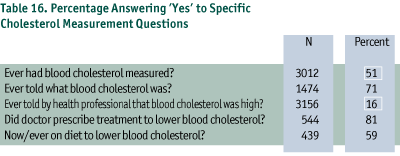
Approximately one-half of the population (51%) reported having had their cholesterol level checked and 16% reported being told by a health professional that it was high. Of these, the majority had been prescribed treatment by a physician and/or had been on a diet (now or in the past) to lower their blood cholesterol levels (Table 16).
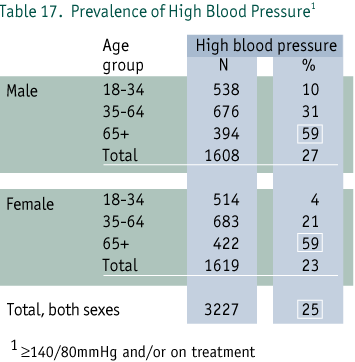
High blood pressure9 is a known risk factor for CVD and kidney failure (Hasford, 1992; Nova Scotia Heart Health Program, 1992). Detection and control of high blood pressure have important implications for reducing the CVD risk within the population. It is therefore recommended that all Canadians over the age of 25 years have their blood pressure checked as part of any routine health examination and that the patient be informed of their blood pressure reading in numbers, to improve both the understanding of their condition and compliance with treatment. (The Canadian Task Force on the Periodic Health Examination, 1994).
Three-quarters of adults had blood pressures in the normal range and one- quarter had high blood pressure. The over-65 year age group was more likely to have high blood pressure, with 59% of both men and women of this age affected. Under age 65, women were less likely than men to have high blood pressure (p < 0.05) (Table 17). Although virtually all adult Nova Scotians had their blood pressure checked at some time, most often by a doctor, only 43% had been told their reading in numbers (Table 18).
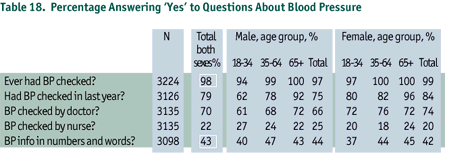
Given that uncontrolled high blood pressure puts people at risk for heart disease and stroke, it is important to know whether the 25% of Nova Scotians with elevated blood pressure were being treated and controlled (blood pressure brought to less than 140/90 mmHg). Of the 948 men and women with high blood pressure, a full 75% had not achieved control. Reasons for this high rate of uncontrolled high blood pressure included: 31% of affected individuals were unaware of their condition, 15% were aware but had received no treatment (more males than females were in this group, p < 0.05), and 29% were aware but treatment had not been successful (Table 19).
[1] Cell is suppressed (-) when the
unweighted number of respondents is less than 30.
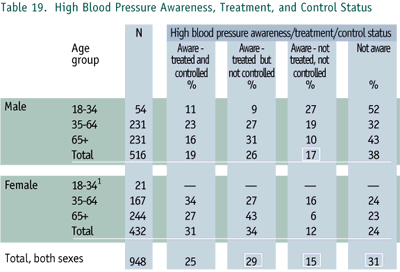
Of the 697 adults who were told they had high blood pressure and were prescribed treatment, 80% reported being advised to take medication to control their condition. Other less frequent responses included salt restriction, weight control, exercise, stress control, smoking cessation, and consuming less alcohol (Table 20).
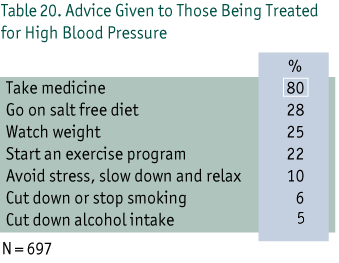
Cigarette smoking is one of the major modifiable risk factors for CVD and other diseases such as cancer (Nova Scotia Heart Health Program, 1992; Makomaski Illing&Kaiserman, 1995). Although smoking rates have declined somewhat over the past 25 years, smoking continues to be a significant cause of illness and death among Nova Scotians (Stachenko, et al., 1992).
One-third of Nova Scotians were smokers. Overall, more men than women were daily (1 or more cigarettes/day) and heavy smokers (25 or more cigarettes/day) (p < 0.05). Twenty-nine percent of adults were daily smokers, and the highest prevalence for both sexes appears to be in the 25-44 age range (Table 21). Of the daily smokers, 34% were heavy smokers and the greatest percent were men age 45-54 (Table 22)
[1] smokes >1 cigarette/day every
day
[2] does not smoke at the present time, but has smoked daily in the past
[3] does not smoke at present time and has never smoked daily in the past.
[1]Cell is suppressed (-) when the
unweighted number of respondents is less than 30
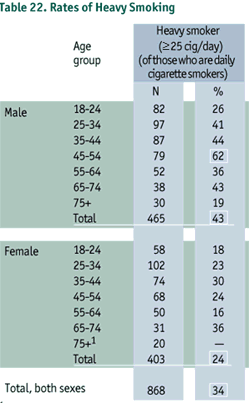
Research has identified exposure to second-hand smoke or environmental tobacco smoke (ETS) as an important health-related issue with impact on CVD and cancer rates (Shepard, 1992; Steenland, 1993; Wood&White, 1991). In fact ETS increases risk of death by 20 to 30% for non-smokers married to smokers. (Heart and Stroke Foundation of Canada, 1994). When asked about exposure to ETS, approximately one out of four respondents was exposed to ETS almost every day at work or in other places outside the home. More men than women were exposed, especially at work (p < 0.05). Thirty-four percent of non-smokers reported being exposed (Table 23).
Nearly a quarter of Nova Scotians indicated that ETS created health problems for them, with more women (28%) than men (17%) being affected (Table 24). An important policy issue is the effect of ETS on the health of non-smokers. Twenty-seven percent of non-smokers believed they were experiencing health problems, and another 16% reported experiencing irritation from exposure to ETS.
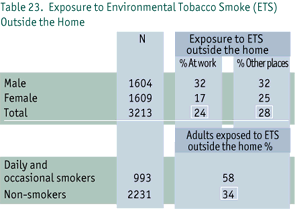
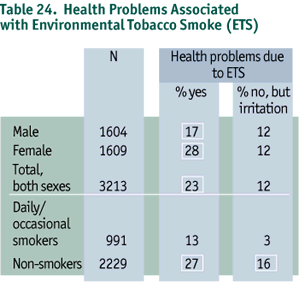
By far, breathing difficulties (51%) were the most commonly reported health problems from ETS, followed by eye irritation (32%), headaches (15%), and nausea (4%) (Table 25).
Physical activity can reduce the likelihood of a person developing heart disease, high blood pressure, osteoporosis, and possibly diabetes. It can also have a positive effect on a person's overall well-being, mental health and self-image. In fact, physical inactivity (sedentary living) is a very important risk factor for heart disease (Fletcher, et al., 1995; Nova Scotia Heart Health Program, 1992; Pate, et al., 1995).
Sixty-one percent of adults reported engaging in some leisure time physical activity, while 39% reported no such activity. Females were more likely to be sedentary than males (p < 0.05), and sedentary living increased with age such that in the over-65 age group, 49% of men and 66% of women were inactive. Generally, men were more active during their leisure time than women at all ages, and young men reported much higher levels of strenuous activity. However, a high percentage of young men (27%) and women (36%) age 18- 34 were sedentary (Table 26).
[1] Light sports (e.g.bowling, baseball,
biking, yard work, etc.)
[2] Strenuous sports (e.g. basketball,
running, skiing, swimming, etc.)
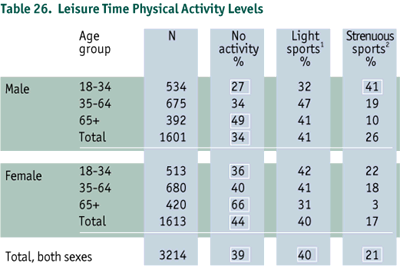
Alcohol consumption is an important issue for health because it contributes to numerous acute and chronic physical, psychological, and behavioural problems. Although alcohol-related problems are more frequent in heavy drinkers, low levels of chronic alcohol consumption can produce health problems for people who otherwise fit within the social norms of alcohol use. (Rankin&Ashley, 1992).
While 2,456 Nova Scotians (76% of respondents ) consumed alcoholic beverages in the past year and the percentage was similar for both sexes, men consumed alcohol more frequently, and in greater quantities than women (Tables 27 and 28). The majority of female drinkers (73%) and less than half of male drinkers (46%), reported drinking two or fewer times per month. While a relatively small percentage of adults reported drinking four to seven days a week (12% of males and 4% of females), the numbers in this category increased with age, especially for males, with 24% of those aged 65 and over reporting this frequency (Table 27).
When asked to report the number of drinks consumed in the past week, men consumed on average six drinks, three times the level reported by women (Table 28).
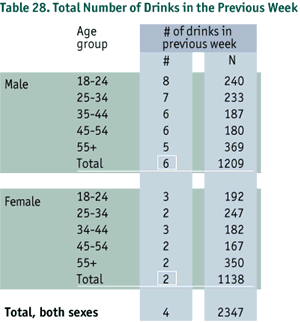
In order to investigate the level of heavy drinking, respondents were asked the number of times they consumed five or more drinks on one occasion in the past year, and more men (69%) than women (39%) reported this behaviour (Table 29). The majority of women who reported this level of drinking, indicated a low frequency of one to six times in the previous year. Men reported drinking heavily much more often, with 22% indicating a frequency of 25 or more times in the past year. The proportion of men who reported drinking heavily decreased with age. The data suggest that although drinking frequency increases with age for men, the number of drinks per occasion decreases.
When interpreting these results it is important to note that gender differences in body weight and physiology affect alcohol metabolism such that women generally need to consume less alcohol than men to achieve a similar blood alcohol level.
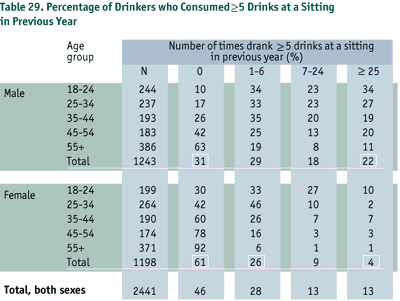
It is known that the presence of one CVD risk factor increases the chance of developing CVD. Further, having two or more risk factors simultaneously causes an amplification of each individual risk with the net effect being an even greater chance of developing CVD (Martin, Hulley, Browner, Kuller,&Wentworth, 1986; Rose, 1981; Stamler, Wentworth&Neaton, 1986).
While approximately 30% of Nova Scotians did not have any of the major risk factors (high blood cholesterol, high blood pressure, or cigarette smoking), it is of concern that 70% did have one or more. Further, 25% of adults had two or more major risk factors. The prevalence of having two risk factors appeared to increase with age (Table 30).
[1]Major CVD risk factors = high blood cholesterol, high blood pressure, cigarette smoking.